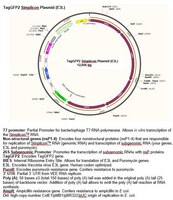SCR725 MilliporeTagGFP2 Simplicon® Plasmid (E3L)
To determine optimal transfection conditions to express the self-replicating RNA of your interest through using Simplicon® Cloning Vector (E3L) (Part #:SCR724) in hard-to- transfect somatic or primary cells
More>> To determine optimal transfection conditions to express the self-replicating RNA of your interest through using Simplicon® Cloning Vector (E3L) (Part #:SCR724) in hard-to- transfect somatic or primary cells Less<<Productos recomendados
Descripción
| Replacement Information |
|---|
| References |
|---|
| Product Information |
|---|
| Biological Information | |
|---|---|
| Concentration | Please refer to lot specific datasheet. |
| Physicochemical Information |
|---|
| Dimensions |
|---|
| Materials Information |
|---|
| Toxicological Information |
|---|
| Safety Information according to GHS |
|---|
| Safety Information |
|---|
| Storage and Shipping Information | |
|---|---|
| Storage Conditions | TagGFP2 Simplicon® Plasmid (E3L) (Cat. # SCR725). One (1) vial containing 10 µL of Plasmid (1 µg/µL). Store at -20 °C. |
| Packaging Information | |
|---|---|
| Material Size | 1 vial |
| Transport Information |
|---|
| Supplemental Information |
|---|
| Specifications |
|---|
| Global Trade Item Number | |
|---|---|
| Número de referencia | GTIN |
| SCR725 | 04054839501777 |
Documentation
TagGFP2 Simplicon® Plasmid (E3L) Ficha datos de seguridad (MSDS)
| Título |
|---|
Ficha técnica
| Cargo |
|---|
| TagGFP2 SimpliconTM Plasmid (E3L) |
Manuales del usuario
| Cargo |
|---|
| SimpliconTM Expression System: Designing Cloning and RNA Synthesis for Expression of Self-Replicative RNA |
Secuencia vectorial
| Cargo |
|---|
| TagGFP2 Simplicon Plasmid (E3L) |







